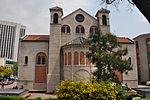Sontag Hotel
1902 establishments in KoreaBuildings and structures completed in 1902Buildings and structures demolished in 1922Demolished buildings and structures in South KoreaDemolished hotels ... and 1 more
Korean Empire

Sontag Hotel (Korean: 손탁 호텔) was the first European hotel in Korea. It was built in 1902, in Jung District, Seoul, Korean Empire. The hotel was sold in 1917 and eventually demolished in 1922.The 25-room hotel was bestowed to a German Russian, Antoinette Sontag, by Emperor Gojong. She was the sister-in-law of the Russian ambassador, Karl Waeber. It is said that she could speak German, Russian, English and also some Korean, gaining wider acknowledgement from the royal family. However, she was almost expelled from Korea when Japan's influence in Korea grew. In September 1909, J. Boher assumed ownership of the hotel.
Excerpt from the Wikipedia article Sontag Hotel (License: CC BY-SA 3.0, Authors, Images).Sontag Hotel
Deoksugung-gil, Seoul Sogong-dong
Geographical coordinates (GPS) Address Nearby Places Show on map
Geographical coordinates (GPS)
| Latitude | Longitude |
|---|---|
| N 37.568888888889 ° | E 126.975 ° |
Address
서울덕수초등학교
Deoksugung-gil 140
03185 Seoul, Sogong-dong
South Korea
Open on Google Maps






